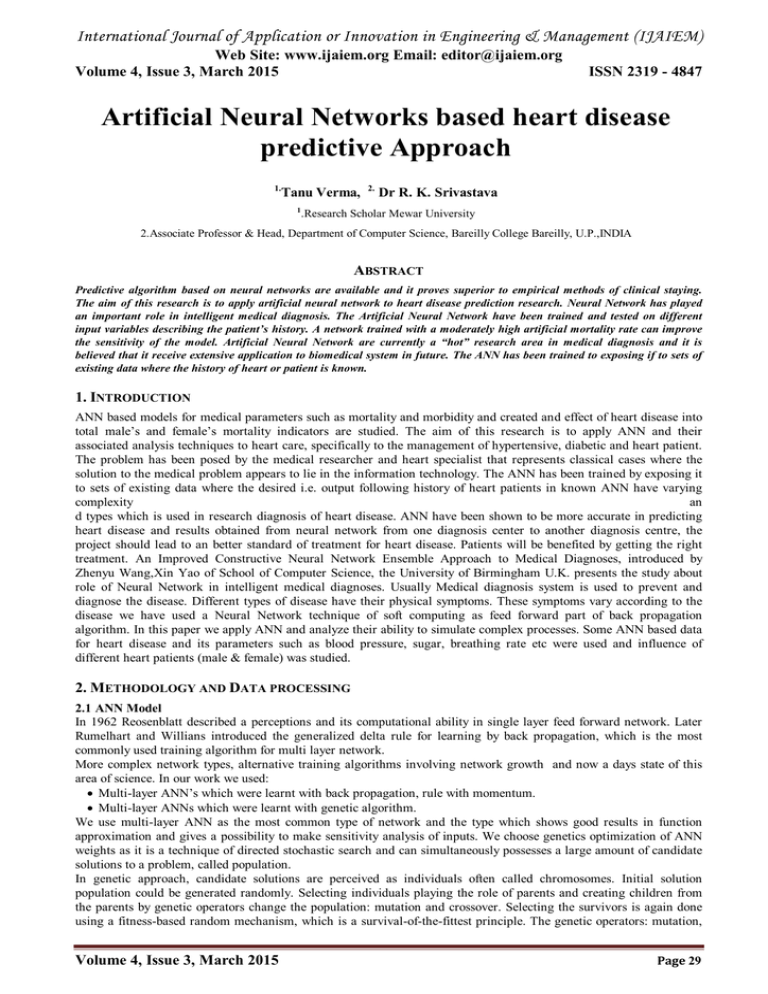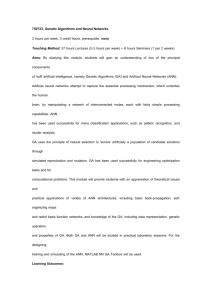International Journal of Application or Innovation in Engineering & Management... Web Site: www.ijaiem.org Email: Volume 4, Issue 3, March 2015
advertisement

International Journal of Application or Innovation in Engineering & Management (IJAIEM)
Web Site: www.ijaiem.org Email: editor@ijaiem.org
Volume 4, Issue 3, March 2015
ISSN 2319 - 4847
Artificial Neural Networks based heart disease
predictive Approach
1.
Tanu Verma,
1
2.
Dr R. K. Srivastava
.Research Scholar Mewar University
2.Associate Professor & Head, Department of Computer Science, Bareilly College Bareilly, U.P.,INDIA
ABSTRACT
Predictive algorithm based on neural networks are available and it proves superior to empirical methods of clinical staying.
The aim of this research is to apply artificial neural network to heart disease prediction research. Neural Network has played
an important role in intelligent medical diagnosis. The Artificial Neural Network have been trained and tested on different
input variables describing the patient’s history. A network trained with a moderately high artificial mortality rate can improve
the sensitivity of the model. Artificial Neural Network are currently a “hot” research area in medical diagnosis and it is
believed that it receive extensive application to biomedical system in future. The ANN has been trained to exposing if to sets of
existing data where the history of heart or patient is known.
1. INTRODUCTION
ANN based models for medical parameters such as mortality and morbidity and created and effect of heart disease into
total male’s and female’s mortality indicators are studied. The aim of this research is to apply ANN and their
associated analysis techniques to heart care, specifically to the management of hypertensive, diabetic and heart patient.
The problem has been posed by the medical researcher and heart specialist that represents classical cases where the
solution to the medical problem appears to lie in the information technology. The ANN has been trained by exposing it
to sets of existing data where the desired i.e. output following history of heart patients in known ANN have varying
complexity
an
d types which is used in research diagnosis of heart disease. ANN have been shown to be more accurate in predicting
heart disease and results obtained from neural network from one diagnosis center to another diagnosis centre, the
project should lead to an better standard of treatment for heart disease. Patients will be benefited by getting the right
treatment. An Improved Constructive Neural Network Ensemble Approach to Medical Diagnoses, introduced by
Zhenyu Wang,Xin Yao of School of Computer Science, the University of Birmingham U.K. presents the study about
role of Neural Network in intelligent medical diagnoses. Usually Medical diagnosis system is used to prevent and
diagnose the disease. Different types of disease have their physical symptoms. These symptoms vary according to the
disease we have used a Neural Network technique of soft computing as feed forward part of back propagation
algorithm. In this paper we apply ANN and analyze their ability to simulate complex processes. Some ANN based data
for heart disease and its parameters such as blood pressure, sugar, breathing rate etc were used and influence of
different heart patients (male & female) was studied.
2. METHODOLOGY AND DATA PROCESSING
2.1 ANN Model
In 1962 Reosenblatt described a perceptions and its computational ability in single layer feed forward network. Later
Rumelhart and Willians introduced the generalized delta rule for learning by back propagation, which is the most
commonly used training algorithm for multi layer network.
More complex network types, alternative training algorithms involving network growth and now a days state of this
area of science. In our work we used:
Multi-layer ANN’s which were learnt with back propagation, rule with momentum.
Multi-layer ANNs which were learnt with genetic algorithm.
We use multi-layer ANN as the most common type of network and the type which shows good results in function
approximation and gives a possibility to make sensitivity analysis of inputs. We choose genetics optimization of ANN
weights as it is a technique of directed stochastic search and can simultaneously possesses a large amount of candidate
solutions to a problem, called population.
In genetic approach, candidate solutions are perceived as individuals often called chromosomes. Initial solution
population could be generated randomly. Selecting individuals playing the role of parents and creating children from
the parents by genetic operators change the population: mutation and crossover. Selecting the survivors is again done
using a fitness-based random mechanism, which is a survival-of-the-fittest principle. The genetic operators: mutation,
Volume 4, Issue 3, March 2015
Page 29
International Journal of Application or Innovation in Engineering & Management (IJAIEM)
Web Site: www.ijaiem.org Email: editor@ijaiem.org
Volume 4, Issue 3, March 2015
ISSN 2319 - 4847
crossover and selection continue until meet the stopping criterion (minimal of an error function or given number of
epoch.
2.2 ANN structure: Artificial neural networks provide a robust approach to approximate real-valued, discrete valued
and vector-valued target functions from some very complex (input, output) data pairs. Many attributes valued pairs
represent input data.
The most common neural network architecture is a fully connected node web. Every edge on the web has a weight
associated with it. Each input node accepts an input data X={X1,X2,…XN}. All other nodes on hidden layers and output
layer compute the linear combinations of the inputs from their immediate backward layers apply a threshold on the
result and send the outputs to their immediate forward layers. Often the threshold is a sigmoid function.
2.3 Computation of ANN forecasted value: Data sets are two parts training and testing. In our testing data there are
43 input sets and one output of 5 patients .Considering the patient pathological and other test reports related to heart
disease as input x(k) and particular S. No. of patient data set to be predicted as desired output d(k) after applying the
BPA, the calculated output is treated as predicted value of cor. Angiogram. The steps adapted for calculation of
predicted cor. Angiogram value i.e. output through BPA is as follows:
Step 1: Data set of patient S. No. 1 to 39 as input set and Coronary Angiogram value of patient S. No. 39 as desired
output.
Step 2: Data set of patient S. No. 1 to 40 as input set and Coronary Angiogram value of patient S. No. 40 as desired
output.
Step 3: Data set of patient S. No. 1 to 41 as input set and Coronary Angiogram value of patient S. No. 41 as desired
output.
Step 4: Data set of patient S. No. 1 to 42 as input set and Coronary Angiogram value of patient S. No. 42 as desired
output.
Step 5: Data set of patient S. No. 1 to 43 as input set and Coronary Angiogram value of patient S. No. 43 as desired
output.
The algorithm has been implemented through C programming language, considering two hidden layers and
computations have been made by an optimized ANN with 43 hidden nodes and after 500and 1000 epochs. Out of these,
the best suitable forecasted values have been obtained by model with 1000 epochs. The result so obtained has been
illustrated in Table 1 as follows:
Table-1
Volume 4, Issue 3, March 2015
Page 30
International Journal of Application or Innovation in Engineering & Management (IJAIEM)
Web Site: www.ijaiem.org Email: editor@ijaiem.org
Volume 4, Issue 3, March 2015
ISSN 2319 - 4847
3.RESULT & CONCLUSION
The proposed artificial neural network technique has been implemented to have diagnosis of heart disease. We have
considered the indirect relation of various parameters for time series data and presume that their relations are time
invariant. The motivation of the study is to diagnose the heart disease, data are collected through various sampling
techniques having different age groups of patients which shows the nonlinearity in data sets and obtained the diagnostic
result through ANN using back propagation algorithm. A network requires information only on the input variable for
diagnostic system. As values on test data are comparatively less the diagnostic model is reliable. The availability of data
have tremendous amount of imprecision and uncertainty due to test reports of the patients are based on involvement of
different electronic and mechanical equipments. Network performance could have been further improved by providing
more training data. Moreover the considered connectionist models are robust, capable of handling the approximate data
and therefore should be more reliable in worse situation. Optimal result will depend on the selection of parameters
which is based on test results and symptoms of the patients. It is evident through the study that neural network model is
even suitable over human diagnostic system. The motivation of the study is that the pathological test data are collected
through various sampling and based on the reading of electronic machines, involving vagueness. Comparison of
forecasted coronary angiogram test value of the patient obtained through ANN using back propagation algorithm with
actual coronary angiogram value of the patients are listed in table-2.
Table-2
Volume 4, Issue 3, March 2015
Page 31
International Journal of Application or Innovation in Engineering & Management (IJAIEM)
Web Site: www.ijaiem.org Email: editor@ijaiem.org
Volume 4, Issue 3, March 2015
ISSN 2319 - 4847
Fig.- Actual Cor.Angio. Vs Forecasted Cor.Angio. Values
In the study the target patient S.NO. 39 to 43 for the prediction of coronary angiogram value computed through the
ANN method. Preliminary results shows that this system can be useful in daily routine practice of medical researchers
and hospital clinicians and the best performance is 99.31% success of correct diagnosis has achieved , could be
interesting that allows the best result provides forecast of higher accuracy. Further the trends in forecast by proposed
method have been compared with the forecast by other available methods like linear model, moving average method,
fitting the polynomial of degree three method and fuzzy sets, our ANN model shows better results than other methods.
REFERENCES
[1] Chou-An Chen[2007], Neuro –Fuzzy Technology as a Predictor of Parathyroid Harmonse Level in Hemodialysis
Patients,Tohku J,Exp.Med.,211,81-87
[2] Ferdous Ahemad Sohel, A new Neural Network with Fuzzy Technique, Disease diagnosis, A Case study,Dept. of
Computer Science & Engg.,International Islamic University-Dhaka
[3] Holmstr,M. L. Koinstinen P, [1992],using Additive Noise in Backpropagation Training,IEEE Transaction on
Neural Networks,pp 24-38,vol 3No. 1
[4] K.K.Shukla,Raghunath,[1999],An Efficient Global Algorithm for Supervised Training of Neural
Networks,International Journal of Computers and EE,PERGAMON Press,25,pp 195-218
[5] R. Brause, F Friedrich[2000],A Neuro Fuzzy Approach as Medical Diagnostic Interface,pp 201-206
[6] S Moein,a Monadjemi[2006],A Novel Fuzzy-Neural Based Medical Diagnosis System,volume 1, Number 3
[7] V.S. Kodogiannis,MBoulougoura[2007], An Adaptive NeuroFuzzy Approach for the Diagnosis in Wireless
Capsule endoscopy Imaging,International Journal of Information Technology,Vol. 13 No. 1
[8] Werbos Paul J. [1990], Back propagation through time: what it does and how to do
it,Proceeding of the
IEEE,78,1550-1559.
[9] Yang CC[1998],The use of back propagation neural network for the sim. & analysis of time series data
,Transcations of the ASAE,41,1181-1187
Volume 4, Issue 3, March 2015
Page 32





